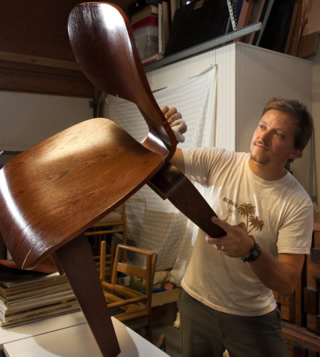Out of this World - Page 2
 |
|
|
Justin occasionally incorporates images of mid-century modern architecture into his work, and these images can be charming—at times. There's one of a woman relaxing on a fireplace, its cantilevered deck much like that in the Woods' own home, with walls of glass behind her opening onto a snow-scape.
Another shows a butterfly-roofed modern home overlooking the sea with what appears to be a mechanical monster taking over the swimming pool.
 |
|
|
A mood that's threatening—or at least unnerving—is common in Justin's work. There are images of folks fleeing, of blasted machinery, of landmine-detecting rats.
Justin's image of “augmented reality interfaces for mobile devices,” for the Italian version of Wired magazine, borrows from the image of God giving life to Adam on Michelangelo's Sistine Chapel ceiling, one of his many works that borrow from classic art.
His ‘Who Needs Humans?', an unpublished illustration for Newsweek, portrays a woman being constructed out of data—or being turned into data. She looks none too happy.
 |
|
|
One of Justin's personal pieces, ‘Shelter Seashore,' shows two brightly garbed individuals fleeing from what appears to be a landing craft—in fact, Justin says, it's an image based on architect Oscar Niemeyer's Brasilia—while being attacked by or morphing into a strange creature.
Like many of his works, this one has a bit of narrative: “They hid under the earth from their creation, ignorant of the havoc they were newly creating. Twisting and twitching roots pulsing in a glorious disarray as the future crashed to the ground behind them.”
His can seem a dark world indeed, a future in which utopia and dystopia are indistinguishable.
 |
|
|
Who needs humans indeed? Will people one day live forever, as ‘Singularity' prophets led by futurist Ray Kurzweil propose? Kurzweil, author of The Singularity Is Near, suggests mankind can achieve immortality not as biological creatures but as data. Human minds will merge with super-computers and meld into one huge world mind-floating in the cloud.
Is that really something to look forward to?
Justin, who grew up in the Bay Area, largely in Emeryville and Palo Alto, says his art was influenced both by his mother, an artist, former model, and a woman with a strong sense for vintage fashion, and his father, a software engineer and musician who collaborated with avant-garde music composers Terry Riley and La Monte Young and helped develop the MIDI standard for electronic music.
A merging of the minds perhaps?
“I feel like there's a big fusion there, with my mom's sort of like analog, fashion-artistic sense, and my dad's musical, computer, more logical thinking,” Justin says. “I really do see a distinct melding there of those two.”
Back in the beloved 1950s, folks confronted the age of anxiety, the atom bomb, automation, depersonalization. The figure to fear was what so many were becoming, the man in the gray flannel suit.
 |
|
|
Today, the anxiety remains, but instead of the bomb (actually, in addition to the bomb) we face a new sort of annihilation, as every day, with every move we make in virtual space or real space, our keystrokes are counted, our photos are taken, our lives are opened for all to see.




